Carnatic wars
| Carnatic wars | ||||||||
|---|---|---|---|---|---|---|---|---|
| Part of the Anglo-Indian wars | ||||||||
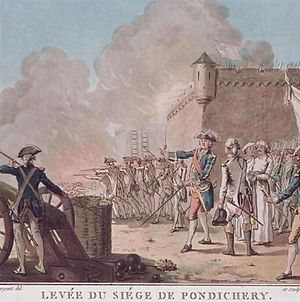 End of the siege of Pondicherry in 1748. | ||||||||
| ||||||||
| Belligerents | ||||||||
| ||||||||
| Commanders and leaders | ||||||||
|
| ||||||||
The Carnatic wars were a series of military conflicts in the middle of the 18th century in India's coastal Carnatic region, a dependency of Hyderabad State, India. The first Carnatic wars were fought between 1740 and 1748.
The conflicts involved numerous nominally independent rulers and their vassals, struggles for succession and territory, and furthermore included a diplomatic and military struggle between the
As a result of these military contests, the British East India Company established its dominance among the European trading companies within India. The French company was pushed to a corner and was confined primarily to
Background
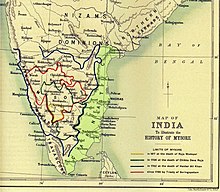
The
One major instigator of the Carnatic wars was the Frenchman
"The Austrian War of Succession in 1740 and later the war in 1756 automatically led to a conflict in India...and British reverses during the American War of Independence (1775–1783) in the 1770s had an impact on events in India."[2]
First Carnatic War (1746–1748)
In 1740, the
With the termination of the War of the Austrian Succession in Europe, the First Carnatic War also came to an end. In the Treaty of Aix-la-Chapelle (1748), Madras was given back to the British in exchange for the French fortress of Louisbourg in North America, which the British had captured. The war was principally notable in India as the first military experience of Robert Clive, who was taken prisoner at Madras but managed to escape, and who then participated in the defence of Cuddalore and the siege of Pondicherry. The French retained their position as the protectors of nizams of Hyderabad.
Second Carnatic War (1749–1754)
Though a state of war did not exist in Europe, the
Third Carnatic War (1757–1763)
The outbreak of the
Aftermath
The war concluded with the signing of the
Gallery
-
The British surrender of Madras, 1746.
-
TheNawab of the Carnatic, Chanda Sahib, assisted by a small number of troops from the French East India Company
-
Robert Clive fires a cannon in the Siege of Arcot.
-
French and English boats position nearFrench National Archives.
-
Death of theAnwaruddin Mohammed Khanin a battle (battle of Ambur) against the French in 1749 (by Paul Philipoteaux).
-
Lally at Pondicherry.
-
The Black Hole of Calcutta, 20 June 1756.
-
Jean Law's Memoire: Mémoires sur quelques affaires de l'Empire Mogol 1756–1761 contains detailed information about the campaign of the
-
English guns at the battle ofPlassey, 23 June 1757.
-
Nawab of Bengal, Mir Qasim at the Battle of Buxar
-
Mughal artillerymen at Plassey during the Carnatic wars.
-
Madras[5]
See also
References
- ^ Benians, Ernest Alfred; Newton, Arthur Percival; Rose, John Holland (1929). The Cambridge History of the British Empire. p. 126. Retrieved 16 December 2014.
- ^ ISBN 9788131300343.
- ^ Dodwell, H. H. (ed), Cambridge History of India, Vol. v.
- ^ "Niall Ferguson – Empire: How Britain Made the Modern World – Why Britain? 4/5". Archived from the original on 31 March 2021. Retrieved 28 September 2014 – via YouTube.
- ^ Palk Manuscripts, four-volume collection of the correspondence of Sir Robert Palk relating to Indian affairs, Historical Manuscripts Commission: Report on the Palk manuscripts in the possession of Mrs Bannatyne of Haldon, Devon, p.XII [1]


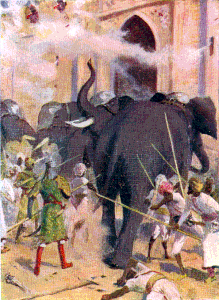
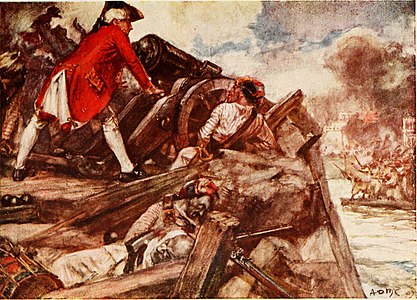

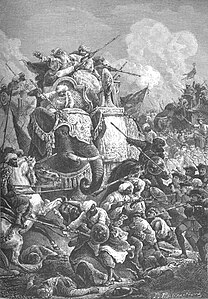

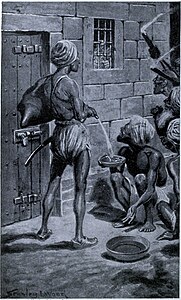
![Jean Law's Memoire: Mémoires sur quelques affaires de l'Empire Mogol 1756–1761 contains detailed information about the campaign of the Mughal Emperor Shah Alam II and his French allies against the British East India Company.[4]](http://upload.wikimedia.org/wikipedia/commons/thumb/3/34/Shah-alam-ii-mughal-emperor-of-india-reviewing-the-east-india-companys-troops-1781-1894_1247854.jpg/395px-Shah-alam-ii-mughal-emperor-of-india-reviewing-the-east-india-companys-troops-1781-1894_1247854.jpg)



![Stringer Lawrence and Nawab Wallajah in Madras[5]](http://upload.wikimedia.org/wikipedia/commons/thumb/d/d7/Stinger_Lawrence_and_Nawab_Wallajah.JPG/204px-Stinger_Lawrence_and_Nawab_Wallajah.JPG)